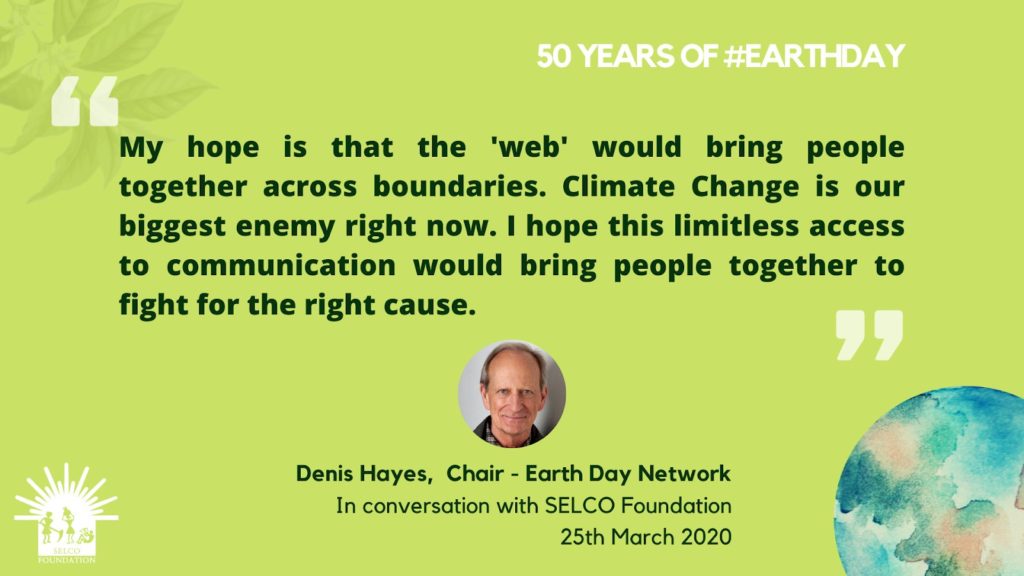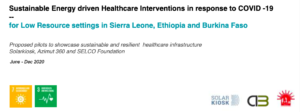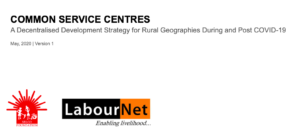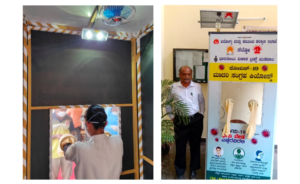SELCO Foundation, on its 10 year anniversary, spoke to Dennis Hayes on the significance of the 50 years of Earth Day- its relevance today and what we can learn to develop a more inclusive and sustainable post COVID19 World.
This year marks the 50th Earth Day bringing people together globally to observe climate change and how to combat it. Started in the 1970s it stands for one of the biggest civil society movements which captured the imagination of the United States of America and rapidly spread to the rest of the world. Today, Earth Day is widely recognized as the largest secular observance in the world, marked by more than a billion people every year as a day of action to change human behavior and create global, national and local policy changes. The Earth Day Network works towards climate action, science and education, mobilizing people and communities, conservation and restoration, plastic and pollution across the world.
Denis Hayes: Hero of the Planet
In the 1970s, Denis Hayes, a young environmental activist along with Wisconsin senator Gaylord Nelson kick started the movement with teach-ins on college campuses to generate awareness on the evils of climate change. They chose 22nd April to observe Earth Day which immediately sparked media attention and through the support of students, civilians, civil rights groups, civil society and local politicians who participated in this historic rally. “We managed to have 1 in every 10 Americans participate. This was made possible by building channels and getting public media to participate,” says Hayes. He looks back and recalls how for many Americans it was the first Political Movement that they had participated in. “It (Earth Day) was recognised as a broad encompassing movement that dealt with social justice, peace, non-violent, human rights- tying all these issues with the environment.” The Earth Day saw humans as a function of a larger natural system and not separate from it, and according to Hayes that is what made the world unify behind it.
The movement however, grew bigger than Hayes could have anticipated 50 years back and went on to gather political support and influence policies where they were able to pass 20 critical pieces of bills like clean water act, clean air act, endangered species act, environment protection act etc. One of the most influential campaigns of the movement was the creation of the US Environmental Protection Agency.
And that was not it. Hayes was determined to make changes through policy, and when policy makers were not convinced, he built demonstrable projects on the ground that showed how environmental sustainability could be achieved in a financially sustainable manner. Over the years, Hayes has led the Bullitt Foundation which has worked towards protecting ecologically valuable lands, restoring natural habitats, climate activism and much more. The landmark Bullitt Building has been deemed as the “greenest office building in the world” by World Architect magazine. Hayes explains, “40% of all energy in the United States goes into running buildings and machinery housed in them which led us to think of the foundation building as something dramatically more sustainable at no increased cost. The entire building is solar powered- it is a net energy positive building; we capture rainwater – about 50,000 gallons; and an in-built sewage treatment.” It was also connected to public transportation, reducing the need of a parking lot. All these measures and careful scrutinization of what is of critical importance to the building and its sustainability, makes the Bullitt Building perform better than any building with a Lead Rating, while also making it commercially viable. A model that should be replicated across the globe.
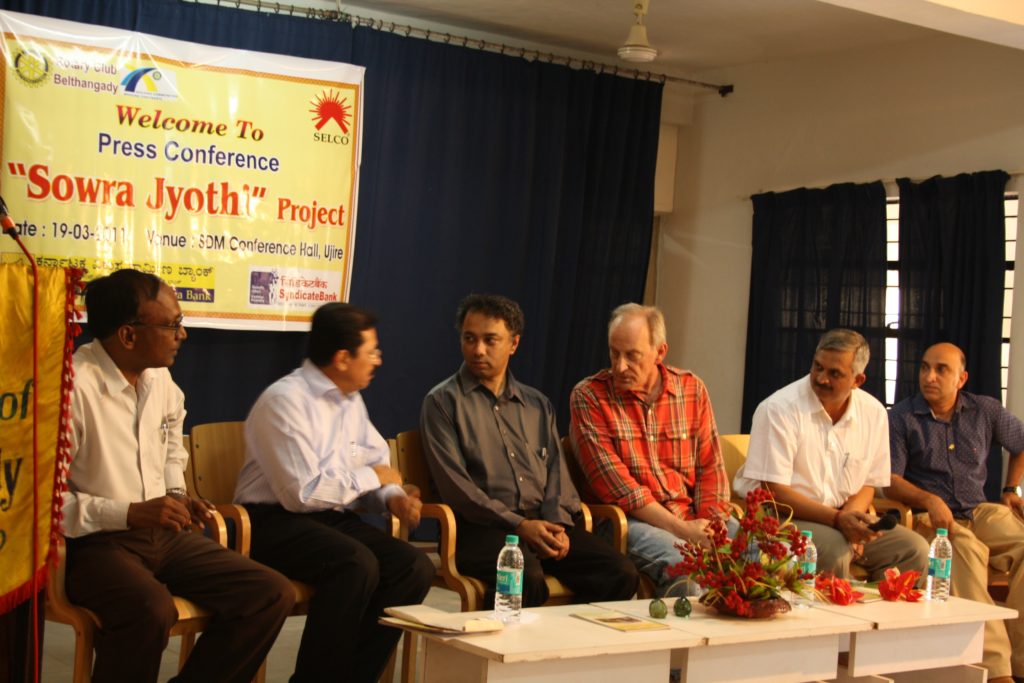
Denis Hayes at the Inauguration of its first Integrated Energy Centre in Dharmasthala, Karnataka implemented by SELCO Foundation. The Solar Energy Centre in Dharmasthala is a solar powered energy rental centre, run for shops in the temple town. Over the past 10 years, the solar energy centre has provided lights to over 100 shops, providing clean drinking water to thousands of pilgrims, and provides refrigeration services for the flower shops nearby. The model has been replicated across the country and beyond.
India: Innovation Centre for Economic and Environmental Sustainability
When asked what gave birth to this massive movement and thought process, Hayes says, “Post the 60s, there was a marked deterioration happening between the growth of the gross domestic product, the growth of the country and the overall well being of the country. There were water pollution problems, lakes dying, freeways cutting through vibrant landscapes. There were major air pollution problems back then. The air then in Pittsburgh or say Gary Indiana in Chicago was very similar to the air in New Delhi today.”
Speaking about the approach behind the Bullitt Building further, Hayes demonstrates how unsustainable practices also costs development of the human race- a lesson that India should take forward, a country which faces both developmental and environmental challenges today. Hayes especially thought that the learnings from Bullitt Building should be taken to housing for disadvantaged. Commenting on SELCO Foundation’s work through its Built Environment portfolio, Hayes spoke about how we need to create models for healthy housing for the disadvantaged. The housing solutions provided today, he went on, “has terrible lighting and poor cooling or heating systems, no insulation. It consumes more energy, results in less productive and increasingly unhealthy people; leaving them in a disadvantaged position for generations.” There is a need to innovate practically and build solutions which are affordable and long term.
-Hayes recalls visiting India in 2011, where he visited an Integrated Energy Centre in Dharmasthala, Karnataka. Founded in October, 2010, this Solar Energy Centre was one of the first innovative initiatives taken by SELCO Foundation and it was an honour to have Hayes inaugurate it. The centre was run by a local entrepreneur housing a solar powered charging centre for services needed by people in a temple town. “It was a model that I had not seen in operation before. The creativity was in finding a solution in a low-resource setting. You didn’t need a solar energy system in every house or shop, but a combination of a solar system and batteries serving a wider community. Somebody had the capital to invest in a business, others had the need for it which could be served.” India is a microcosm of the world, with varied geographies, culture and socio-economic contexts. This places the country in a unique position to innovate for the world- innovate in a manner that we reach our developmental goals in a healthy manner.
In a Post Covid-19 World- Paving a Sustainable and Inclusive Future Ahead
The 2018 Multidimensional Poverty Index showed that in addition to the 1.3 billion classed as poor, an additional 879 million are at risk of falling into multidimensional poverty, which could happen quickly if they suffer setbacks from conflict, sickness, drought, unemployment and more. Particular to India, 8.5% of our population lies in poverty, whereas 19% are in an acute risk of falling into multidimensional poverty because of a small setback. In the past few weeks, COVID-19 is one such setback which will push millions decades back in development.
COVID-19 has demonstrated the fragility of our system and showcases how there is an urgent need to build strong safety nets for our disadvantaged groups. Harish Hande, the founder and CEO of SELCO Foundation notes, “COVID-19 is a disaster that has unified us and affected the rich and the poor. But for the poor, COVID-19 is an everyday reality.” Post the crisis and learning from the environmental movement which Hayes is a part of, we need to make sure that we rebuild with action towards climate, poverty and development. Climate change has undeniable links with development; it is a developmental issue which needs to be addressed along with all other metrics of development. “We have to be able to pull together as a planet, as a species. We need to start tackling climate change with a unified passion,” ends Hayes on a hopeful note.
